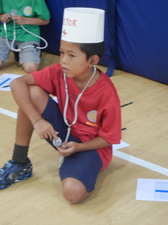 The grade 3 Body Systems unit of inquiry is now in full swing here at NIS. The grade 3 teaching team consisting of Marina Gijzen, John Rinker, and Georgia Perry and I have been meeting and planning this UoI together which has resulted in our students engaging in some excellent learning experiences related to the different body systems at work. The use of stethoscopes to determine heart rate was introduced to the students earlier in the week and at our last collaboration meeting, it was decided that we would include the use of these stethoscopes in the following PE lesson. As I was planning on having the students record their own heart rates and record these heart rates on a record sheet in the next PE class, we came up with a better plan which was to also have the students use stethoscopes as well. I revised the record sheet to also include a section for heart rate determined by stethoscope. The kids were paired off at the start of today’s class. I made up doctor’s hats for the partner who would be using the stethoscope. The other partner (the patient) would be the one engaged in physical activity at various levels of intensity. However, each partner would get a chance to be the doctor and use the stethoscope. The students (the patients) were responsible for recording their own rate (on neck or wrist), as well the doctor would simultaneously determine their heart rate as well using the stethoscope. The 6-second formula was used to keep it simple. For those who didn’t read my previous blogs about the 6-second formula, it is very easy. On my command ‘begin counting’, I use a stopwatch to count off 6 seconds. On my command ‘stop counting’, the students add a zero to the number of heart beats in 6 seconds (for example, 14 beats in 6 seconds would be 140 beats a minute). This determines their number of beats per minute which will be recorded. As you can see on the record sheet above, there are 2 sections. One for ‘Tactile’ heart rate (heart rate determine by feeling pulse in wrist or on neck) and one section for ‘Auditory’ heart rate which is determined by the doctor using a stethoscope. The students took part in 5 different activities, each having a go as patient (the one exercising) and as doctor (the one sitting and watching, ready to use stethoscope on patient to determine heart rate). The activities were as follows: 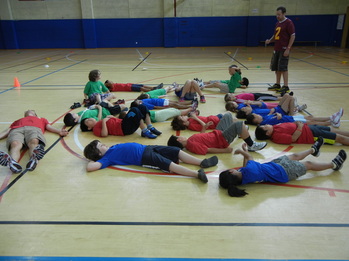 Resting Heart Rate (completely at rest): The kids simply rest for a few minutes then determine their own heart rate and record this number on the record sheet. The doctor takes their heart rate as well and reports number of beats per minute back to the patient. Patient records this number as well under ‘Auditory’ column. Switch!! Patient becomes doctor, doctor becomes patient and same game is played. 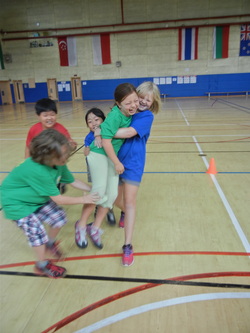 Save the Injured Person Game (Light Exercise): Students (the patients) are divided on to 2 teams. Each team must pick out three people who act as though injured. The others must safely carry the injured person, one at a time about 10 meters. The team then carefully puts the injured person down. The whole team then carries another injured person the same distance back. After 3 injured people have been moved, all students run back to their own doctor. The patient takes their own heart rate and records it. Doctor takes their heart rate as well and reports number of beats per minute back to the patient. Patient records this number as well under ‘Auditory’ column. Switch!! Patient becomes doctor, doctor becomes patient and same game is played. 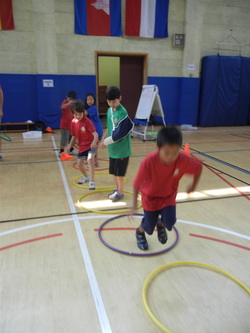 Bean Bag Capture (Medium Intensity): Using the same ten meter distance as the Save the Injured Person game, the students, on teams, must build a hula hoop bridge to cross this 10-meter area. They are only allowed to move within the hoops (over the bridge). Once the bridge extends across the imaginary river, the whole team crosses the bridge and begins to collect bean bags which are spread out, on the floor, on the other side of the river. Taking only three bean bags at a time, they must quickly cross the bridge back and drop the bean bags in their team area. They return over to collect three more and repeat process until all of the bean bags have been collected. Once all the bean bags have been collected, they must disassemble their bridge bringing hula hoops back to the original side of the river. Return home and the patient takes their own heart rate and records it. Doctor takes their heart rate as well and reports number of beats per minute back to the patient. Patient records this number as well under ‘Auditory’ column. Switch!! Patient becomes doctor, doctor becomes patient and same game is played. Domes and Dishes (High Intensity Exercise): 20 dome cones are laid out on the floor. Ten turned upward as if they were dishes or bowls. 10 remain down as if domes. Students, still on 2 teams, are either the domes team or the dishes team. On ‘Go’ command the students must run out and continually turn cones over to either dishes or domes (depending on what team they are on). At the end of the game, whichever team has turned more over wins. They rush back to the doctor to determine heart rate. The patient takes their own heart rate and records it. Doctor takes their heart rate as well and reports number of beats per minute back to the patient. Patient records this number as well under ‘Auditory’ column. Switch!! Patient becomes doctor, doctor becomes patient and same game is played. Cool Down (Light Exercise): Students, both doctor and patient, slowly walk around gym and talk about games they have played. They talk about what they have learned. They make their way back to their team area in order to determine and record cool down heart rate. The patient takes their own heart rate and records it. Doctor takes their heart rate as well and reports number of beats per minute back to the patient. Patient records this number as well under ‘Auditory’ column. Video Please see video below of some snippets of the great times today! Example Student Assessment: The students were excellent as was their classroom teacher, John Rinker (http://johnrinker.edublogs.org/), who came along to class to help out and take part in the activities. Please view slide show below to see some examples of student assessment and some photos of the kids in action. A great day at NIS.
3 Comments
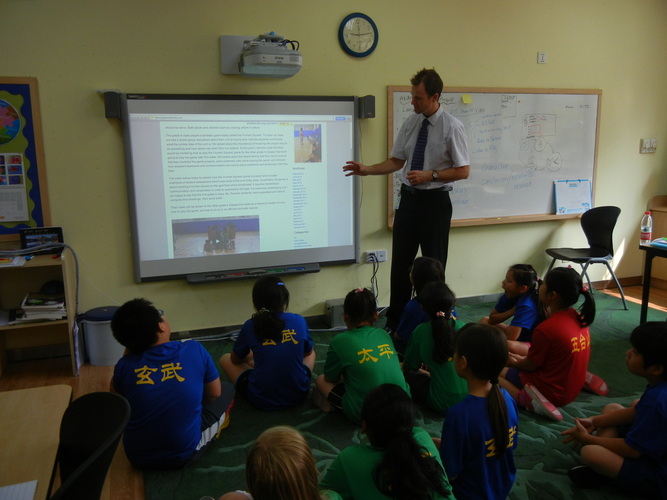 Grade 4 NIS teacher, Matthew Perry, and his class watching video from previous day's grade 4 class completing adventure challenge task. The peer modeling process unfolding..... I blogged yesterday about a link I am making in PE with the current 'Who We Are' grade 4 unit of inquiry. In helping to make a connection with the lines of inquiry and the central idea in this UoI, we (the grade 4 teaching team and myself) decided that there was great value in letting the students in one class model how certain games are suppose to be played. As we are doing an adventure challenge unit in PE at the moment, cooperative learning, teamwork, communication, and trust are essential components of what is happening in class. Letting kids model these important skills can be an extremely effective teaching tool. The grade 4 class today, taught by Matthew Perry, watched the video on my blog from yesterday's class. They had a whole group discussion about the importance of teamwork, cooperation, risk-taking, being principled, trusting one another, and how to effectively communicate before coming to PE to do the same Human Square challenge as yesterday's class. The concept of yesterday's class modeling for their class was understood. Matthew did a great job at taking it one step further in discussing how they could also model for tomorrow's grade 4 class and that there was a distinct possibility that they will have learned to do the game better than yesterday's class due to having it modeled for them by the peers. As predicted, there was better communication by Matthew's class and they did in fact do an overall better job than yesterday's class at completing the Human Square challenge. Tomorrow's grade 4 class will also participate in the same challenge and will have a chance to see today's video as well as yesterday's. I believe that there is great merit in a process such as this. Although not integration, these learning experiences will hopefully help the students to genuinely make stronger connections to the current 'Who We Are' unit. 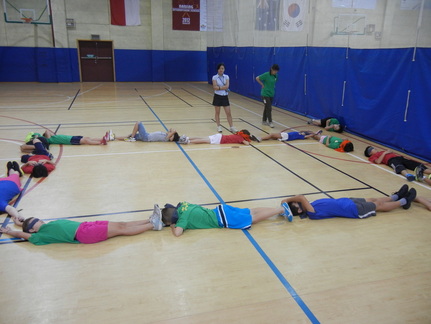 Although I am not fully integrating into the grade 4 unit of inquiry on ' Who We Are', I am helping to lend support to this UoI by addressing some of the concepts/main ideas that the students are learning in the classroom. When we examine the central idea of this unit, 'We look to others for a model of how to live', the very first thing that comes to my mind is how powerful video and modeling can play in helping to teach one another the way something should be done. Both adults and children learn by viewing others in action. The grade 4 class played a fantastic game today called the 'Human Square'. To open up class, we had a whole group discussion about their unit of inquiry and I had the students summarize what the central idea of this unit is. We talked about the importance of modeling the proper way to do something and how others can learn from our actions. At this point, I told the class that they would be modeling how to play the 'Human Square' game for the other grade 4 classes that were going to play the game later this week. We talked about the responsibility that they had to ensure that they modeled the game properly, were extremely safe while playing the game, and showed how excellent teamwork and communication can help to solve problems and challenges that they face. The video below helps to explain how the 'Human Square' game is played and includes examples of student assessment which was done at the end of the class. Essentially, the game is about creating a human square on the gym floor while blindfolded. It requires tremendous communication and cooperation in order to accomplish this task. It is extremely challenging, but I am happy to say that the first grade 4 class, Ms. Renee's students, were superstars and able to complete this challenge. Well done kids!! Their video will be shown to the other grade 4 classes this week as a means to model not only how to play the game, but how to do so in an efficient and safe manner. 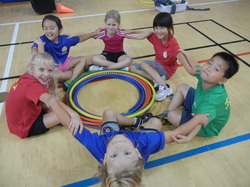 The Rights and Responsibilities grade 2 unit of inquiry is now in the third week and the PE integration is going quite well helping to lend support to the classroom teachers. Through collaboration with the grade 2 teaching team, it was decided for the first few weeks that I would look, in particular, at what the student's responsibilities are in PE in general, but more specifically, what their responsibilities are in the games and activities. As we are doing an adventure challenge unit in PE, the students are required to work on teams at solving complex tasks. This type of unit is excellent for addressing both individual and group responsibilities and can generate a lot of very good discussion regarding prosocial behavior. The three games that we played in today's class were: A) Build and Unbuild a Human Bridge In this game the students have to lie on the floor, one at a time, and extend their legs and arms as much as possible as a link in an imaginary human bridge which must span the width of an imaginary river. Once a students lies down and extends their arms and legs, the next students runs from the side of river to add to the bridge, then the next one goes etc. Once they make their imaginary bridge, they must all gather on the opposite side of the river and build the bridge back. The game ends when the team completes the task. They must sit in a circular formation with their arms around one another to show that they have completed the task. B) Build and Unbuild a Bridge of Hula Hoops Same idea as the game described above. However, they must use hula hoops to construct the bridge and stay inside the hula hoops as they cross the river. Once all of the students make it to the opposite side of the imaginary river, they disembark on dry land then make their way back across the river to the original side. They must unbuild the bridge in the process, organize the hoops in an orderly fashion, then form a circle again. C) Build a Bridge to Capture the Gold This game is the same as the hula hoop game described above, however, once they cross the river, the must collect pieces of gold (bean bags) that are scattered about on the far side of the gym and return them back over the river to their home. They can only carry with them one piece of gold at a time. This is important as it forces them to think about how best to get the bean bag back. In the first part of this game the students each grab a bean bag and run like crazy chickens back and forth over the bridge. This invariably causes traffic jams on their own bridge which slows down the entire team. It isn't long before they realize that the more efficient way to get the gold back is to form a line and pass the bean bags along the line over the bridge and back to their home. They must once again finish off by unbuilding the bridge, organizing the hoops, place all of the gold inside of the hoops, and form a circle with arms around one another. The team with the most gold is victorious. Any student who steps out of the hoop and into the river costs their team three bean bags. These 3 bean bags are given to the other team. Formative Assessment To assess the students understanding of what they felt their responsibilities were in this game and to identify what they need to improve, I had them complete the assessment sheet that you see below. I included examples of some of their work. 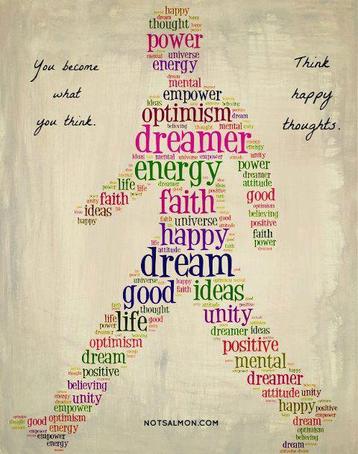 Over the past several years, I have continuously reflected upon the way I teach and assess in PE. It has always been a long term goal of mine to create a more effective way to better assess the enduring concepts, the PYP attitudes and the IB Learner Profile within my PE program. I want my students walking away from their time with me having learned and understood the importance of values such as the ability to persevere through difficulty; to problem solve and think their way through challenging tasks; to set goals and follow through with the necessary action to achieve these goals; to appreciate the rewards that come with improving upon something that we never thought that we could improve upon and to realize the positive energy and sense of achievement that can be developed through teamwork and cooperation. These are only a few of the enduring concepts that I have highlighted. There are so many more, but what I would like to stress today is the value of perseverance. I have recently been researching how to better teach perseverance to students. I came across a great one this morning http://www.parents.com/parenting/better-parenting/style/how-to-teach-kids-perseverance-goal-setting/ and it made me think about an ongoing question that I have always had, 'How can we genuinely assess perseverance in PE?' As a PE practitioner, there is nothing that gives me more of a charge than seeing a student breakthrough and accomplish something they never thought that they could or to improve upon their level of performance through hard work and determination. The image that I have posted along with this blog is one that a friend recently put up on Facebook. I love the picture and, to me, it is representative of all of the great qualities, character traits, and positive thinking that we hopefully hold in high regard in our PE programs. The Body Systems integration continues at NIS. There are three Grade 3 classes at our school and each has had the opportunity to get loads of practice finding their pulse and calculating their heart rate per minute based at different intensities of exercise. They now know, for certain, that the greater the intensity of exercise, the higher the heart rate per minute. Added to this we have had in-depth discussions regarding maximum ranges of heart rate for kids their age (resting rate vs maximum rate).
Documenting what we do in PE and communicating this to the classroom teachers is essential during any integration, so I strive to create PDF posters on A4 or A3 sized paper with the work we do in PE along with pictures to pass along to them. This helps to share where we are in the unit and provides opportunities for the classroom teachers to follow up if and when necessary ensuring to consolidate the students' learning in this unit.  I was fortunate enough to meet Neil on the golf course this summer in California. A mutual friend that I was visiting introduced us. We enjoyed 4 days playing golf and getting to know one another. It was easy to see Neil's passion for physical education and to feel the motivation and drive that he had for our profession. Neil is an experienced workshop leader and highly believes in the value of pedometer use in schools. If you are thinking of introducing pedometers in your classroom or within your school, you will be interested in what Neil has to say. Neil's Bio Neil has been lucky in life, and has found himself presented with a multitude of exciting opportunities. He has lived and worked in the UK, Spain, the UAE, the PRC, the USA, Japan, and currently Singapore, where he continues to teach MS PE. He is in the third year of his M.Ed. program with the American Public University, and is happy to say that he still really enjoys what he does. PE Past and Present: When I finally made it to teaching college back in 1989, I realized a sense of purpose, something that had apparently eluded me for the first 23 years of my life. For the first time I felt that I had the power to make a difference. Notably, as I moved into my first year of teaching I remember stating, “I would be able to do for students what wasn’t done for me in school”. As Daniel Pink (2009) points out in his book Drive, motivation revolves around autonomy, mastery, and purpose, and so I’m not surprised that with my new sense of purpose came a new sense of motivation. Fortunately, I feel that this sense of motivation is still with me, however, I am not necessarily motivated by the same things as I once was. Fortunately, teaching has become far more student centered. At one time our grading systems might have been bell curved with the fastest runners at the top end. Whereas now we really are focused on motivating students toward an involvement in, and an appreciation for life-long physical activity, healthy nutritional choices, and optimal physical, mental, emotional, and social wellbeing. This higher focus allows us to treat each student as an individual, and make a difference in the individual’s life. Indicative of this new approach was the pedometer program that we initiated in the MS while at my last teaching post. We were well aware that pedometer programs had tried and failed in many institutions around the world. Hence we were careful to do our homework. Building the program up before hand, with exclusive access to pedometers for teachers really helped build up the desire on behalf of the students. When the program was finally implemented, the students for the most part approached it with a very responsible attitude. They were asked to log their daily steps, and quarterly reflections into their Google Docs spreadsheet; being a 1 to 1 school only helps with the logistics of this. Being involved in a program such as this really brought home the fact that we had successfully passed the ownership of physical activity onto the student. They were the ones now in charge of their activity levels, and also the ones asked to reflect on their lifestyle choices as indicated by their step counts. Living data such as this also proved very valuable to the math program, as they integrated the numbers into several of their units. Having moved on to a much larger institution, we have had to consider carefully how we go about implementing such a program on such a big scale. However, knowing its value, it is something that we will have to get going in one form or another, as its application in the field of authentic assessment is almost unparalleled. 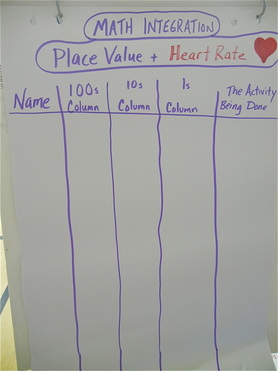 Place Value Maths Link and Taking Heart Rate In an earlier blog I wrote about the collaboration taking place between PE and the unit of inquiry on Body Systems happening in our grade 3 classes at Nanjing International School. We have had an excellent start to the unit with the students already making a strong connection between the different body systems and how these systems are affected by exercise. I aim to fully integrate PE into this unit as it really is a perfect fit. The central idea is ‘We must care for our body systems to be healthy’. The 3 systems that we are going to look at in PE are the circulatory, respiratory, and the muscular. During our collaboration, we had a look at the maths outcomes for this unit. Place value and graphing are among some of the outcomes being covered by the classroom teachers (Marina Gijzen, Georgia Perry, and John Rinker). Lesson Breakdown We began with the students resting for a couple of minutes, lying on their backs and finding their heart rate. It took a few minutes for all of the students to be able to confidently do this. Once they were able to find the HR with certainty, we calculated their beats per minute using the 6-second formula described above. I modeled how to record their heart rate using a place value system on chart paper to prepare them for the actual recording that they will do in the next 2 weeks. We then exercised at various levels of intensity and recorded further. 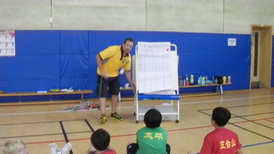 As I did this activity last year, upon teacher reflection at the end of the unit, I realized that I could have greatly improved upon accuracy and efficiency of finding and recording heart rate by taking a class to model how to record on paper and giving them more time to be able to correctly determine heart rate in the first place. Some of my students last year had difficulty counting their own heart rate, so with today's extra practice, I am certain that the students will be better prepared this year. 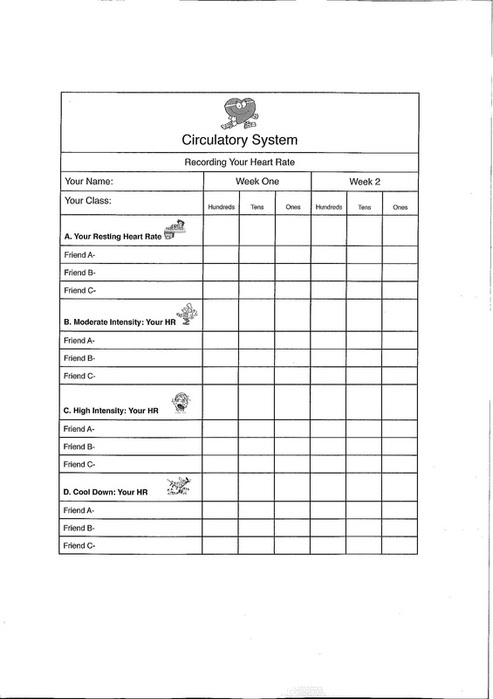 Next Week's Record Sheet The students will be recording their own heart rate and the heart rates of some of their peers using this record sheet. Once completed this record sheet in two week's time, I will give the results to the classroom teacher who will then use the data to create graphs. |
AuthorKAUST Faculty, Pedagogical Coach. Presenter & Workshop Leader.IB Educator. #RunYourLife podcast host. Archives
September 2022
|
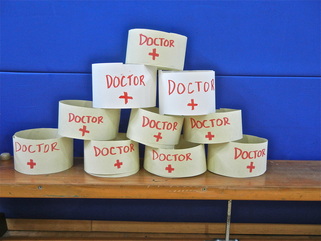
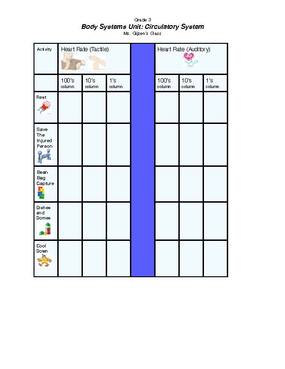
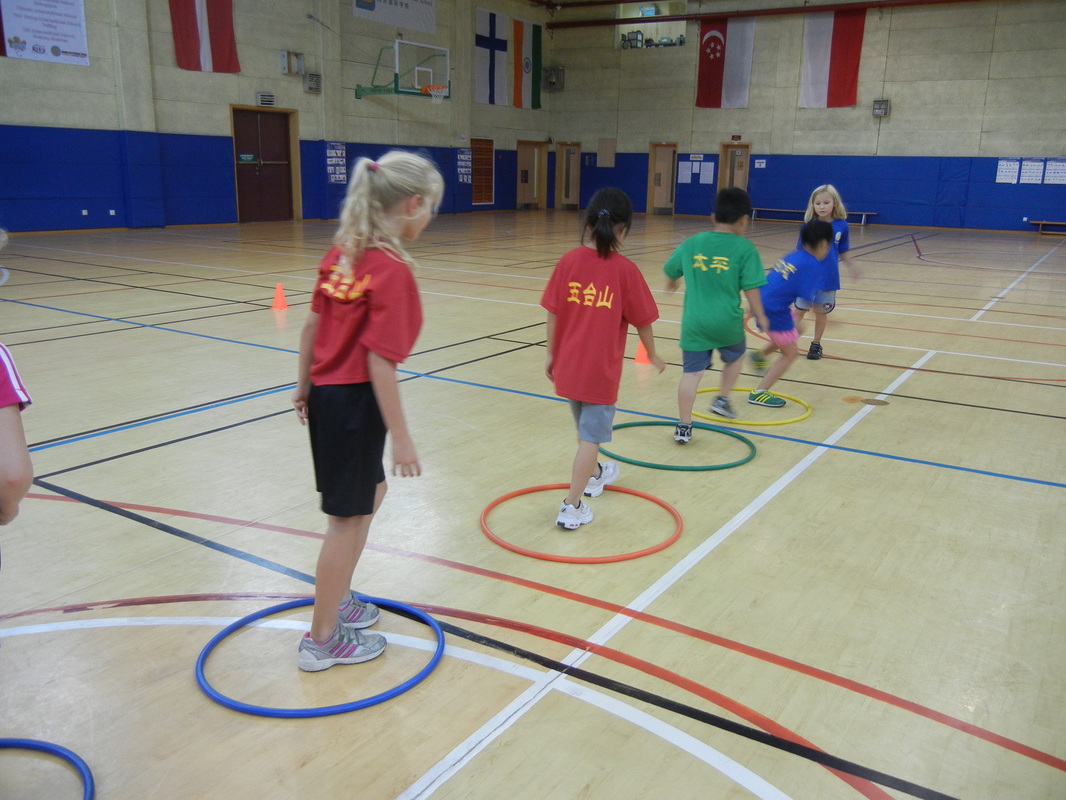
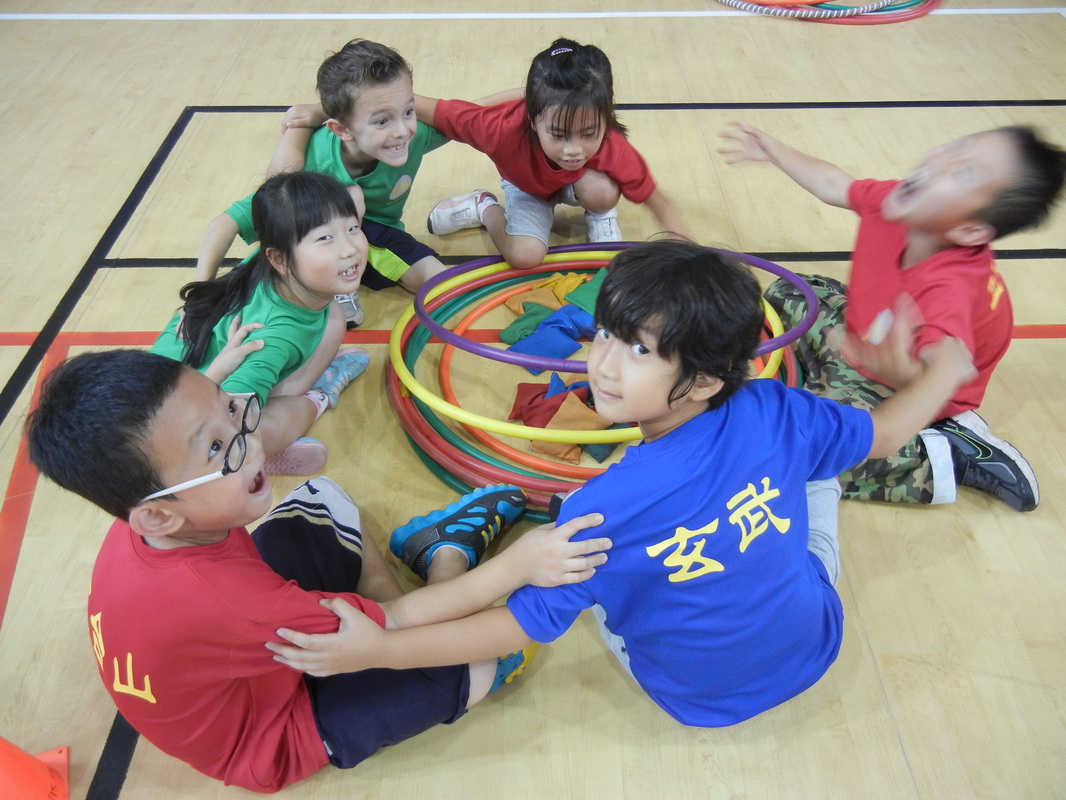
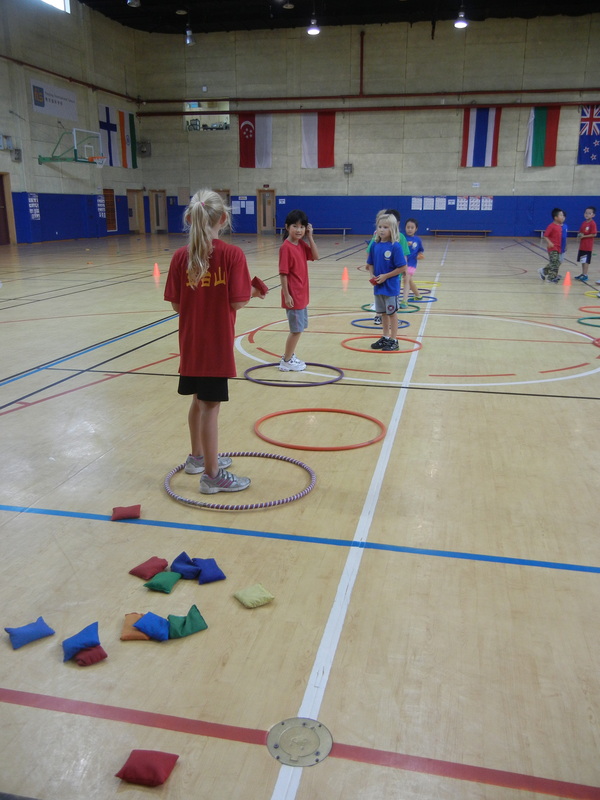
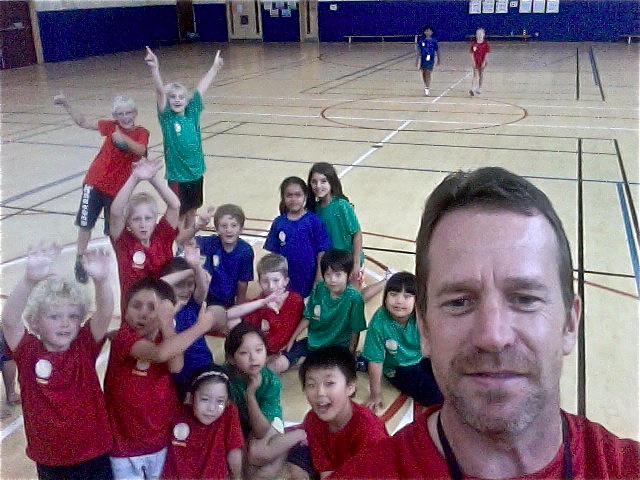
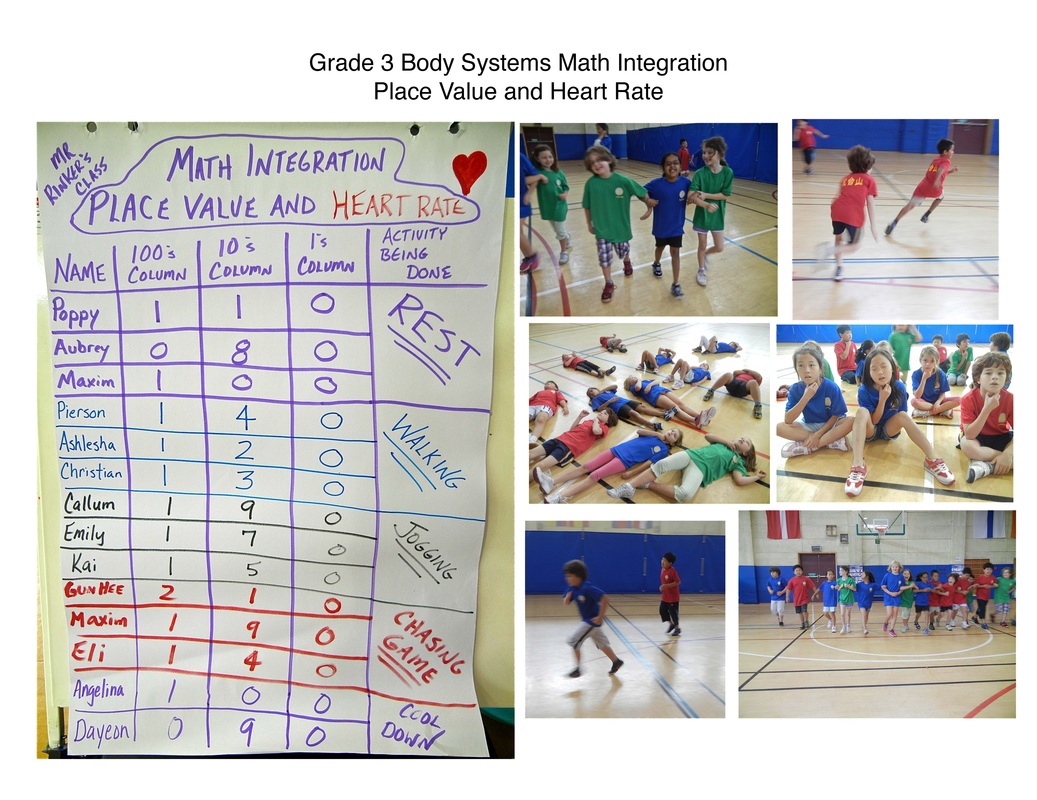
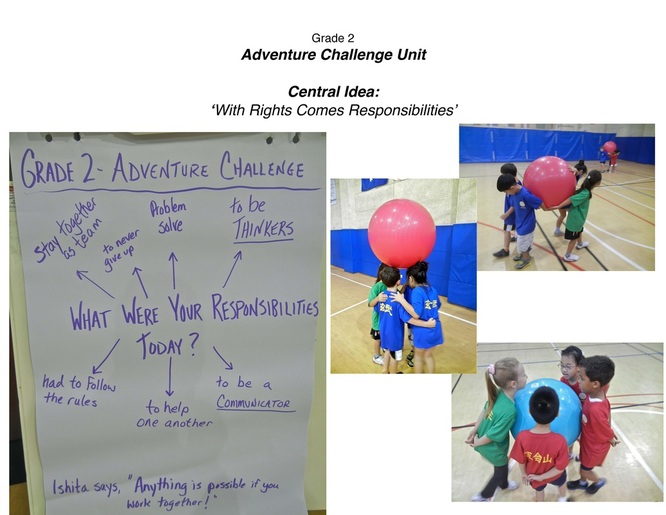
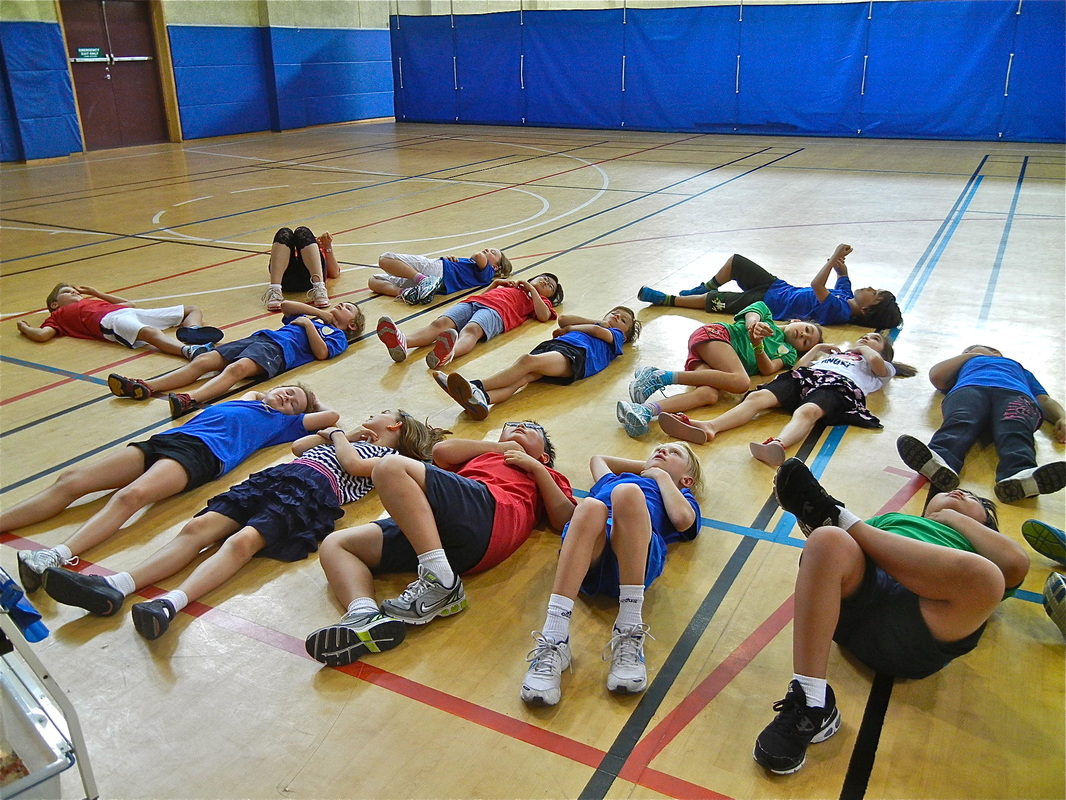
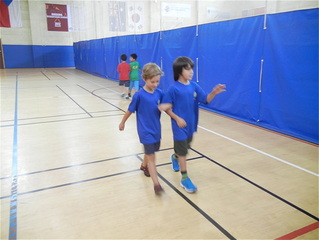
 RSS Feed
RSS Feed